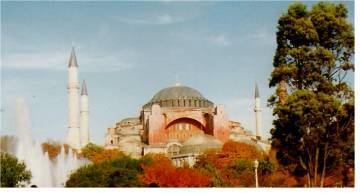Viking Warriors in Istanbul Left Their Marks in Hagia Sophia
Viking warriors in Istanbul....read accounts.
Every since I knew the Vikings warriors in Istanbul left signatures or whatever those cryptic marks are, on the railing in the Hagia Sophia (Ayasofya) museum in Istanbul, Turkey, I've been fascinated with the adventures of the Viking warriors in Istanbul, especially since my long blond haired very Scandinavian looking son, Andrew, spent five years living in Istanbul.
So...when I find any kind of reference of the Viking warriors in Istanbul I love to record it.
The following information about the Viking warriors in Istanbul is from "Conquest by Man," by Paul Hermann and translated from German by Michael Bullock. This book was published under the German title: "Sieben Vorbei Und Acht Verweht", in 1954.
I don't remember where I acquired the book. I'm...well, we, all nine of us, are great at picking up interesting books here, there and everywhere. I've been trying to bring some needed semblance of order to our family library and ran across these neat references to the Viking warriors in Istanbul.

Hagia Sophia Istanbul Photo by Kari
Being of Norwegian decent....I'm always interested in my great grandfathers..the Vikings.
Vikings Warriors in Istanbul then called Byzantium
On their journey down the Dnieper, a route which had been explored by the Northmen as far as the Black Sea long before Rurik, they came first to Kiev. This city, the capital of the Polanians, pleased them so much that they decided to stay. Their rule over the Polanians, whom they quickly overthrew, lasted for twenty years.
Then they were attacked by Helgi, the son and successor of Rurik, who defeated and slew them in 882. Henceforth Kiev was the capital of the Russo-Varangian kingdom. It is recorded that as late as the eleventh century, the majority of the inhabitants of the Viking seat of government were still Scandinavians.
Despite the settlement, the lure of Byzantium remained. In 907 Helgi, with Viking warriors, in Istanbul, reached the Golden Horn, allegedly with two thousand ships. An enormous ransom freed the city from the danger of falling into the hands of the Varangians. In 941 another Northman, Ingvar, Helgi's son, knocked at the gates of Miklagard (Byzantium).
This time "Greekfire", which took a terrible toll of the Northmen, saved the threatened metropolis. But a few years later, Ingvar, whom the Slavs called Igor, was back again weapon in hand. Again Byzantum paid ransom. And again this availed her for one generation. Since then, Russian has made repeated attempts to bring Constantinople under her sway...
...As we have heard, the Varangians (Viking warriors in Istanbul) never succeeded in conquering Constantinople. They infiltrated into the city in large numbers as merchants and soldiers, however. In a military respect especially they soon gained considerable influence. For the Byzantine emperors, who could not always place full reliance on the loyalty of their compatriots, took to composing their bodyguard entirely of Varangians (Viking warriors in Istanbul).
The majority of the latter came from Russia, but no doubt there was a sprinkling from Scandinavia. The first Northman named as being in the service of the Emperor was actually an Icelander who arrived in the Golden City before 950, through a very strange concatenation of circumstances. Ultimately the Varangian Guard of the Byzantine autocrats formed a State within the State, with its own laws and its own jurisdiction. Naturally its leader was always a Varangian; one of them, Harald the Hard (Harald Haardraade), who later became king of Norway. By the thirteenth century the number of Vikings warriors in Istanbul who came to Byzantium had considerably diminished.
The ranks of the Varangian Guard were then largely filled by Englishmen. It continued to exist until 1453, when Constantinople was taken by the Turks. (from pages 329-331)



